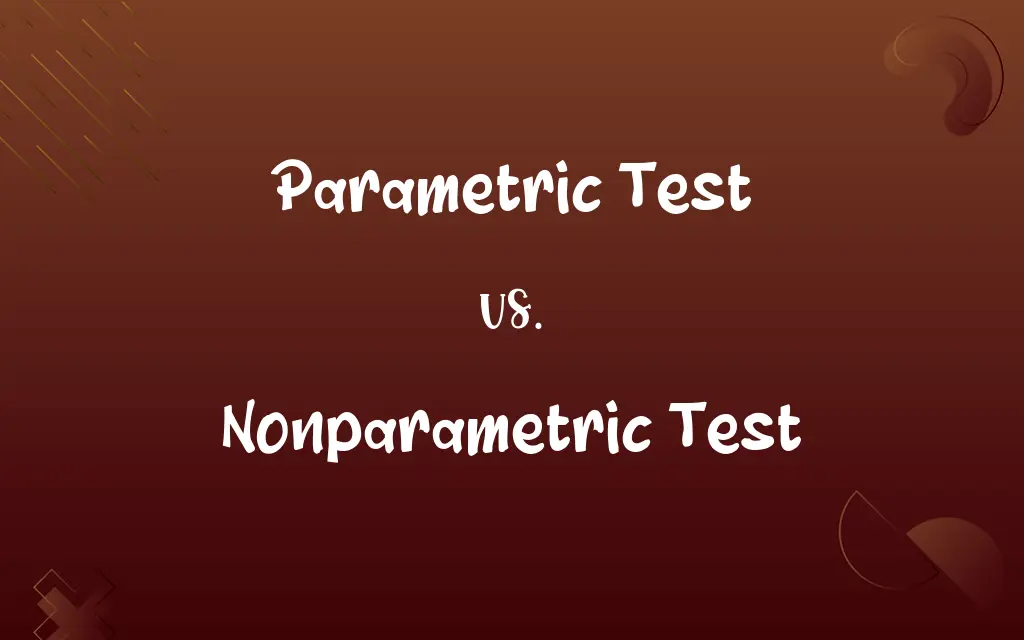Parametric Test vs. Nonparametric Test: Know the Difference

By Shumaila Saeed || Published on January 29, 2024
Parametric tests assume underlying statistical distributions in the data; nonparametric tests do not, making them suitable for non-normal or unknown distributions.

Key Differences
Parametric tests are statistical tests that assume the data follow a certain distribution, typically the normal distribution. They are appropriate for hypotheses about the mean or variance of a normally distributed population. Parametric tests are powerful when their assumptions are met, as they can provide more accurate and reliable results. Examples include the t-test and ANOVA. These tests rely on parameters like mean and standard deviation and are less robust to deviations from normality.
Shumaila Saeed
Jan 29, 2024
Nonparametric tests, on the other hand, do not assume any specific distribution for the data. They are ideal for data that is not normally distributed or when the form of the distribution is unknown. Nonparametric tests are more flexible and can be used with ordinal data or non-numeric data. However, they may be less powerful than parametric tests when dealing with normally distributed data. Examples include the Mann-Whitney U test and the Kruskal-Wallis test. These tests are based on ranks and medians and are more robust to outliers and non-normality.
Shumaila Saeed
Jan 29, 2024
Comparison Chart
Assumption of Distribution
Assumes normal distribution of data.
Does not assume any specific distribution.
Shumaila Saeed
Jan 29, 2024
Data Requirements
Requires interval or ratio data.
Can be used with ordinal or nominal data.
Shumaila Saeed
Jan 29, 2024
Sensitivity to Outliers
Less robust to outliers.
More robust to outliers and non-normal data.
Shumaila Saeed
Jan 29, 2024
ADVERTISEMENT
Hypothesis about
Usually about means or variances.
Often about medians or distribution shapes.
Shumaila Saeed
Jan 29, 2024
Parametric Test and Nonparametric Test Definitions
Parametric Test
It’s based on assumptions of the normality of data and known distribution parameters.
For normally distributed data, the ANOVA, a parametric test, is often the preferred choice.
Shumaila Saeed
Jan 05, 2024
Nonparametric Test
Less powerful than parametric tests but more robust to outliers.
For skewed data, the nonparametric test was more appropriate due to its robustness.
Shumaila Saeed
Jan 05, 2024
Parametric Test
Requires interval or ratio data for valid application.
Using the Pearson Correlation, a parametric test, required interval data for correlation analysis.
Shumaila Saeed
Jan 05, 2024
ADVERTISEMENT
Nonparametric Test
Often used when parametric test assumptions cannot be satisfied.
Given the unknown distribution, a nonparametric test was the best choice.
Shumaila Saeed
Jan 05, 2024
Parametric Test
Parametric tests are suitable for hypothesis testing about population parameters.
The Z-test, another parametric test, was applied to assess the population mean.
Shumaila Saeed
Jan 05, 2024
Nonparametric Test
It’s based on ranks or medians rather than means and variances.
The Wilcoxon test, a nonparametric test, compared medians instead of means.
Shumaila Saeed
Jan 05, 2024
Parametric Test
More powerful than nonparametric tests when assumptions are met.
Given the data's normal distribution, the parametric test provided more reliable results.
Shumaila Saeed
Jan 05, 2024
Nonparametric Test
A Nonparametric Test does not assume a specific distribution and is flexible.
The Mann-Whitney U test, a nonparametric test, was used for the ordinal data comparison.
Shumaila Saeed
Jan 05, 2024
ADVERTISEMENT
Parametric Test
A Parametric Test assumes a specific distribution and uses parameters like mean and variance.
The t-test, a parametric test, was used to compare the means of two groups.
Shumaila Saeed
Jan 05, 2024
Nonparametric Test
Suitable for ordinal or nominal data and non-normal distributions.
The Chi-square test, a nonparametric test, was ideal for the nominal data analysis.
Shumaila Saeed
Jan 05, 2024
Repeatedly Asked Queries
What is a Parametric Test?
A statistical test that assumes data follows a specific distribution, typically normal.
Shumaila Saeed
Jan 29, 2024
When should I use a Parametric Test?
When your data is normally distributed and meets other parametric assumptions.
Shumaila Saeed
Jan 29, 2024
In what situation is a Nonparametric Test preferred?
When data is not normally distributed or has an unknown distribution.
Shumaila Saeed
Jan 29, 2024
Are Nonparametric Tests useful for small sample sizes?
Yes, they can be particularly useful for small samples.
Shumaila Saeed
Jan 29, 2024
Can Parametric Tests be used on ordinal data?
Typically no, they require interval or ratio data.
Shumaila Saeed
Jan 29, 2024
Can I use a Nonparametric Test for ratio data?
Yes, nonparametric tests can be used for various data types, including ratio data.
Shumaila Saeed
Jan 29, 2024
What assumptions do Parametric Tests make about variance?
They often assume homogeneity of variance.
Shumaila Saeed
Jan 29, 2024
What is a Nonparametric Test?
A flexible statistical test that does not assume any specific data distribution.
Shumaila Saeed
Jan 29, 2024
Are Nonparametric Tests less accurate than Parametric Tests?
Not necessarily less accurate, but sometimes less powerful if parametric assumptions are met.
Shumaila Saeed
Jan 29, 2024
How do Parametric Tests handle outliers?
They are less robust to outliers compared to nonparametric tests.
Shumaila Saeed
Jan 29, 2024
Is it easier to perform a Parametric Test?
Not necessarily, it depends on the data and the test requirements.
Shumaila Saeed
Jan 29, 2024
What statistical information do Parametric Tests provide?
They provide insights like mean differences and variances.
Shumaila Saeed
Jan 29, 2024
Which test is better for hypothesis testing about medians?
Nonparametric tests, as they focus on medians rather than means.
Shumaila Saeed
Jan 29, 2024
Can a Parametric Test be used for skewed data?
Generally, no, as they assume normal distribution.
Shumaila Saeed
Jan 29, 2024
Do Nonparametric Tests always involve ranks?
Many, like the Mann-Whitney U test, use ranks, but not all.
Shumaila Saeed
Jan 29, 2024
How do Nonparametric Tests treat nominal data?
They can analyze nominal data effectively, unlike many parametric tests.
Shumaila Saeed
Jan 29, 2024
Are Nonparametric Tests useful in clinical research?
Yes, especially when dealing with non-normal or ordinal data.
Shumaila Saeed
Jan 29, 2024
Can Parametric Tests handle missing data?
Handling missing data can be complex and may affect test validity.
Shumaila Saeed
Jan 29, 2024
Do Nonparametric Tests require data transformation?
Usually, they do not require transformation like normalizing data.
Shumaila Saeed
Jan 29, 2024
Share this page
Link for your blog / website
HTML
Link to share via messenger
About Author
Written by
Shumaila SaeedShumaila Saeed, an expert content creator with 6 years of experience, specializes in distilling complex topics into easily digestible comparisons, shining a light on the nuances that both inform and educate readers with clarity and accuracy.









































































